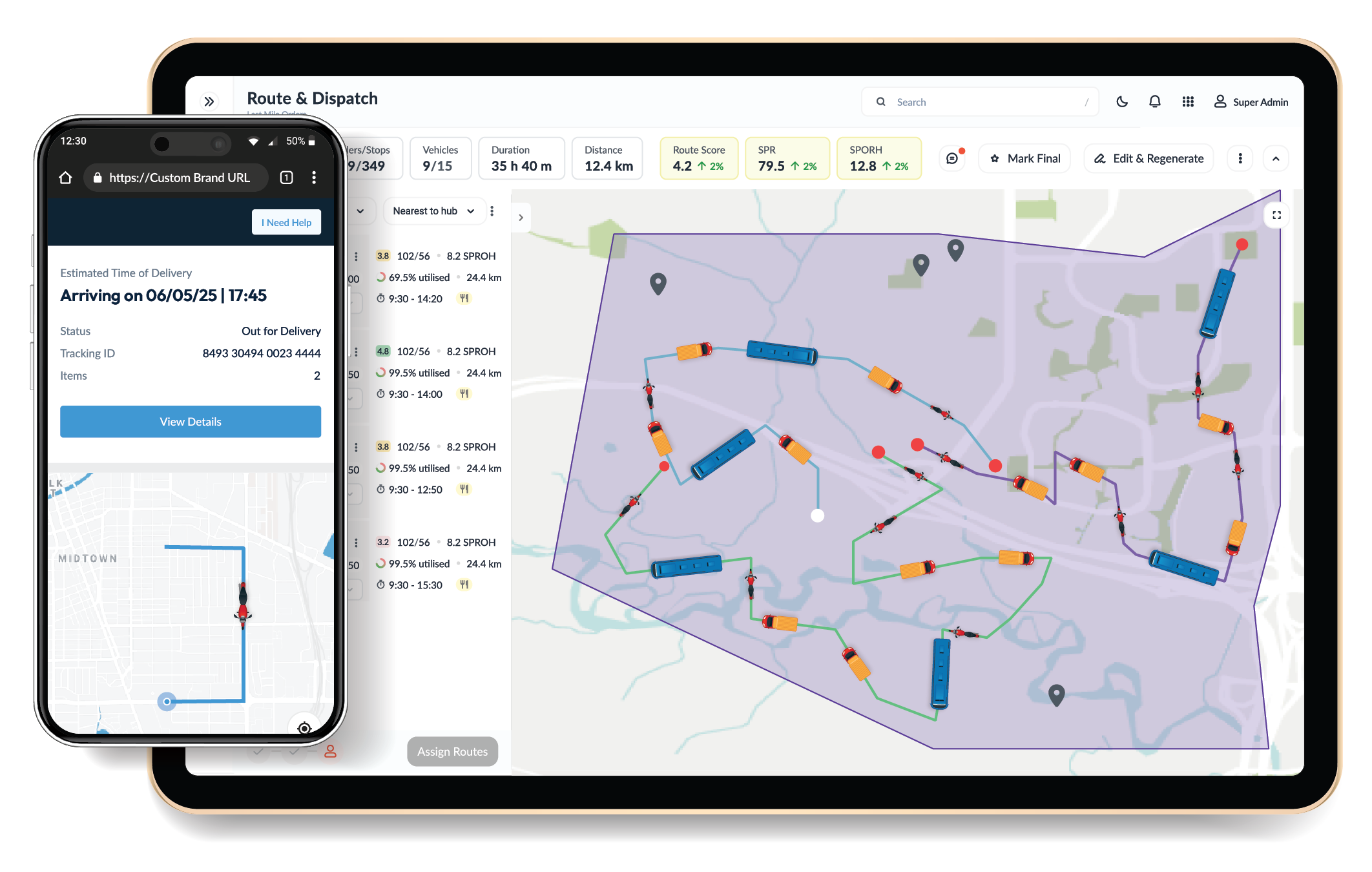- Route
The Business Value of Implementing Capacitated Vehicle Routing Solutions
Table of Contents
- Understanding the Capacitated Vehicle Routing Problem
- Why Manual Planning No Longer Works for Growing Enterprises
- The Core Value Proposition: What Solving CVRP Unlocks
- How Advanced Routing Software Solves the CVRP
- The Business Impact: Measurable Gains for Logistics Teams
- Why AI and Machine Learning are Transforming Routing
- FarEye: Elevating CVRP with Intelligent, Real-Time Routing
- Key Considerations for Implementation
- Sustainable Logistics and the Road Ahead
- Bringing it All Together
- FAQ

Delivering products efficiently has never been more vital for enterprises managing daily bulk shipments. According to a report, transportation accounts for nearly 58% of total logistics spending for most enterprises in the United States.
In this outlook, the ability to orchestrate large fleets, control costs, and meet stringent customer expectations hinges on one crucial decision. It all depends on how well you solve the Capacitated Vehicle Routing Problem (CVRP).
CVRP isn’t just an algorithmic puzzle. It’s the engine room of scalable logistics. For businesses balancing hundreds or thousands of daily orders, capacity-constrained routing separates those who merely deliver from those who dominate their market.

Understanding the Capacitated Vehicle Routing Problem
Every logistics team faces the challenge of sending out vehicles that must be delivered to many stops, but each vehicle can only carry so much. The capacitated vehicle routing problem asks: What’s the smartest way to assign deliveries and plan routes so no truck is overloaded, every order is fulfilled, and costs are kept to a minimum?
CVRP is foundational to modern logistics, but it’s not a problem that gets simpler as you grow. Each new order or delivery point multiplies the number of possible routing combinations. When managed manually, it means long hours, rising error rates, and a ceiling on how much a team can handle before things start slipping through the cracks.
Why Manual Planning No Longer Works for Growing Enterprises
Relying on spreadsheets or basic mapping tools may suffice for small fleets, but bulk delivery operations have outgrown these approaches. For dispatchers and supply chain managers, manual planning brings persistent risks, missed capacity limits, duplicate routes, last-minute reshuffling, and unplanned overtime costs. Even one miscalculation can send costs soaring or leave customers waiting.
As shipment volumes increase, so do the stakes. Enterprises competing in fast-moving markets, whether B2B, B2C, or hybrid, require a smarter, automated way to solve CVRP daily.
The Core Value Proposition: What Solving CVRP Unlocks
Addressing the CVRP with time windows with advanced solutions is about more than mathematics. It’s a direct path to unlocking operational agility, cost efficiency, and superior customer experiences.
When a business implements capacitated vehicle routing, it gains:
- Optimal Fleet Utilization: Trucks are neither overloaded nor underused.
- Reduce Fuel and Maintenance Costs: Vehicles travel fewer unnecessary miles.
- Ensure Predictable Scheduling: Fewer delays and overtime situations.
- Enable Real-time Re-optimization: Sudden volume spikes are absorbed without chaos.
- Boost Customer Satisfaction: Delivery windows are met with accuracy.
These results build the kind of logistics foundation that not only drives profit margins but also opens doors for new business models and market expansion.
How Advanced Routing Software Solves the CVRP
The evolution of routing technology has moved far beyond traditional maps. AI routing platforms apply a mix of combinatorial algorithms, real-time data, and artificial intelligence to turn CVRP from a barrier into a competitive advantage.
With an advanced routing solution, dispatchers can:
- Automate Route Creation and Allocation
Orders and fleet data are fed into the system, and within minutes, the optimal route plan for every vehicle is generated. - Incorporate Real-world Constraints
Live traffic, road closures, weather, and last-minute changes are factored in so plans remain relevant and robust. - Enable Bulk Order Management
Large daily order sets are processed automatically, freeing dispatchers to focus on service rather than spreadsheets. - Provide Dynamic Re-optimization
If a driver calls in sick or a vehicle breaks down, the system instantly recalculates the best use of available resources.
What once took hours of planning can now be completed in minutes and with far greater precision.
The Business Impact: Measurable Gains for Logistics Teams
Choosing the right routing software for VRP with Pickup & Delivery translates directly into measurable business value. Here’s what enterprises typically see after implementation:
- Reduction in Operational Costs
Fewer vehicles are required to meet demand, less overtime, and lower fuel usage. - Productivity Boost
Dispatchers spend less time on routine planning and more on exceptions and customer service. - Customer Satisfaction
On-time deliveries, accurate ETAs, and real-time notifications have become the norm. - Scalability
Peak periods and sudden surges in orders can be handled without adding planning staff.
For many organizations, these improvements can deliver a return on investment within months, not years.
Why AI and Machine Learning are Transforming Routing
Logistics environments are constantly shifting, and traditional rules no longer suffice. This is where artificial intelligence (AI) and machine learning (ML) become vital in routing.
AI-driven routing solutions learn from historical delivery data, recognize patterns in demand, and adapt recommendations to changing conditions. ML models can predict bottlenecks, optimize fleet allocation by route type, and refine delivery windows over time.
As a result, enterprises gain continuous improvement in their routing performance. Delivery plans not only become more efficient but also more resilient as business complexity grows.
FarEye: Elevating CVRP with Intelligent, Real-Time Routing
Today’s leading logistics software brings advanced algorithms, AI, and live data integration together to solve CVRP at scale. FarEye’s platform empowers dispatchers with:
- Automated, constraint-based route optimization that respects all vehicle capacities and delivery time windows.
- Real-time visibility into every route, stop, and vehicle on the road.
- Instant re-optimization when orders change, new deliveries are added, or disruptions occur.
- Intuitive dashboards that turn complex routing into actionable, visual insights for the entire team.
FarEye takes CVRP to the next level. Its routing recommendations are based on actual delivery performance. This ensures that fleets are always deployed for maximum efficiency, even as order profiles and traffic conditions evolve.
Key Considerations for Implementation
Selecting the right capacitated vehicle routing solution is critical for lasting results. Logistics leaders should look for platforms that offer:
- Scalability: Ability to handle today’s volume and tomorrow’s growth.
- Ease of Use: Interfaces that support rapid onboarding and daily adoption.
- Customization: Configurable to unique business rules, fleet types, and customer requirements.
- Robust Support: Responsive vendor support to address evolving operational needs.
Watch Outs
- Poor data quality leads to suboptimal routes.
- Failure to integrate with core systems creates silos.
- Over-customization can slow down platform performance.
Sustainable Logistics and the Road Ahead
Operational efficiency is only one part of the value equation. Effective CVRP solutions also enable enterprises to reduce emissions by optimizing loads and routes, supporting sustainability targets, and complying with future regulations.
The logistics leaders of tomorrow will be those who combine profitability with responsible, sustainable operations made possible through intelligent routing and smart use of technology.
Bringing it All Together
Businesses that tackle the capacitated vehicle routing problem with modern, AI-powered software are building a logistics backbone that enables profitable growth, robust customer relationships, and long-term sustainability.
The days of manual route planning and firefighting are over for enterprises willing to invest in the right tools. With FarEye, solving CVRP is no longer a daily struggle; it’s the foundation for operational excellence and market leadership.
Ready to streamline your delivery network and optimize fleet utilization? Discover how FarEye’s capacitated vehicle routing solution delivers real results schedule a demo today.
FAQ
How quickly can CVRP be implemented?
Most enterprises can deploy and test capacitated vehicle routing within 2–4 weeks, especially with cloud-based solutions like FarEye.
Which data inputs deliver the best results?
Clean order data, accurate vehicle specs, real-time traffic, and capacity limits yield the most effective CVRP results.
Source:

Komal Puri is a seasoned professional in the logistics and supply chain industry. As the AVP of Marketing and a subject matter expert at FarEye, she has been instrumental in shaping the industry narrative for the past decade. Her expertise and insights have earned her numerous awards and recognition. Komal’s writings reflect her deep understanding of the industry, offering valuable insights and thought leadership.
Let's Talk to Our Experts and Optimize Your Deliveries Today!
An expert from our team will reach out within 24 hours
Related resources


